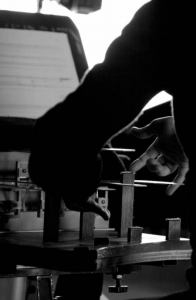Description:
The Rulers [1] is a self-contained musical performance system called a digital musical instrument [3]. It includes a software component to produce music and a physical interface to manipulate it. Originally designed in 2004 as part of CCRMA’s Summer music technology seminar, it is currently undergoing an overhaul so that it is suitable to be played in McGill’s Digital Orchestra.
 The instrument was designed to evoke the gesture of plucking or striking a ruler that is fixed at one end. Because the seven aluminum “tines” are of various lengths, each tine oscillates for a different amount of time when plucked. This provides an element of visual and passive haptic feedback to the player. The design minimizes the acoustic component of the oscillations and vibrations of the tines. While they oscillate silently, their motion is sensed by infrared reflect sensors to control a computer-based synthesizer. Output amplitude is determined by the amplitude of the tine’s oscillation, allowing control over the amplitude of initial excitation and damping — characteristics that classify it as an instrument that outputs musical events with a non-excited middle [5].
The instrument was designed to evoke the gesture of plucking or striking a ruler that is fixed at one end. Because the seven aluminum “tines” are of various lengths, each tine oscillates for a different amount of time when plucked. This provides an element of visual and passive haptic feedback to the player. The design minimizes the acoustic component of the oscillations and vibrations of the tines. While they oscillate silently, their motion is sensed by infrared reflect sensors to control a computer-based synthesizer. Output amplitude is determined by the amplitude of the tine’s oscillation, allowing control over the amplitude of initial excitation and damping — characteristics that classify it as an instrument that outputs musical events with a non-excited middle [5].
 Sensing for The Rulers originally included two options: infrared and Hall effect sensors. We introduced another technology known in applied solid mechanics research and development: the strain gauge. These three sensing technologies were evaluated from several perspectives. We have concluded that considering the variety of musical gestures, none of the sensing technologies is optimal [3]. Thus, we have developed a sensor fusion framework to account for unpredictable input, human gestures. The framework fused data from the three cited sensors, resulting in a more accurate output than each of the sensing sources alone. The framework is replicable to cases whose input is unpredictable. For The Rulers, the framework reached covariance improvements ranging from 4.7 to 12.4 [2]. For this, we count on the assistance of the following students: Pietro Verrecchia (Electrical Engineering Undergraduate Student at McGill) and Anthony Picciachia (Mechanical Engineering at McGill)
Sensing for The Rulers originally included two options: infrared and Hall effect sensors. We introduced another technology known in applied solid mechanics research and development: the strain gauge. These three sensing technologies were evaluated from several perspectives. We have concluded that considering the variety of musical gestures, none of the sensing technologies is optimal [3]. Thus, we have developed a sensor fusion framework to account for unpredictable input, human gestures. The framework fused data from the three cited sensors, resulting in a more accurate output than each of the sensing sources alone. The framework is replicable to cases whose input is unpredictable. For The Rulers, the framework reached covariance improvements ranging from 4.7 to 12.4 [2]. For this, we count on the assistance of the following students: Pietro Verrecchia (Electrical Engineering Undergraduate Student at McGill) and Anthony Picciachia (Mechanical Engineering at McGill)
 Fernando Rocha playing the Rulers as part of the McGill Digital Orchestra Project. [6]
Fernando Rocha playing the Rulers as part of the McGill Digital Orchestra Project. [6]
Video demonstrations from the Digital Orchestra project:
Rulers 1 – Performer: Xenia Pestova
Rulers 2 – Performer: Xenia Pestova
References:
- Joseph Malloch, David Birnbaum, Elliot Sinyor and Marcelo M. Wanderley. A New Conceptual Framework for Digital Musical Instruments. Proceedings of the 9th International Conference on Digital Audio Effects (DAFx-06), Montreal, Canada, 2006.
-
Carolina B. Medeiros and Marcelo M. Wanderley. “Multiple-model Linear Kalman Filter Framework for Unpredictable Signals.” IEEE Sensors Journal, 2013, DOI 10.1109/JSEN.2013.2291683.
-
Carolina Brum Medeiros and Marcelo M. Wanderley. “Evaluating of sensor technologies for The Rulers, a kalimba-like Digital Musical Instrument”. In Proceedings of the 8th Sound and Music Computing Conference, Padova, Italy, 2011.
-
M. M. Wanderley and P. Depalle, “Gestural Control of sound synthesis,” Proc. IEEE, Spec. Issue on Eng. and Music – Supervisory Control and Auditory Communication, vol. 92, no. 4, pp. 632–644, 2004.
-
D. Levitin, S. McAdams, and R. Adams, “Control parameters for musical instruments: A foundation for new mappings of gesture to sound,” Organized Sound, vol. 7, no. 2, pp. 171-189, 2002.
- Sean Ferguson and Marcelo M. Wanderley. The McGill Digital Orchestra: An Interdisciplinary Project on Digital Musical Instruments. Journal of Interdisciplinary Music Studies., 2010.
Project Type:
Interface Development.

